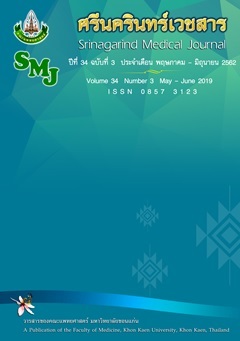Cost-Effectiveness of Crystalline and Amorphous Atorvastatin in the Secondary Prevention of Cardiovascular Disease
Keywords:
cost-effectiveness; atorvastatin; LDL achieve goal; crystalline form; amorphous formAbstract
Background and Objective: Atorvastatin has one of the highest rate of prescribed medications at Queen Sirikit Heart Center of the Northeast, Khon Kaen University. When generic drugs that were equivalent to the original drugs pharmaceutically produced, the generic was included in the list of Hospital medicines at Queen Sirikit Heart Center. However, the original atorvastatin was still available. The original drug was in crystalline form whereas the generic form was in amorphous form. The main objective of this study was to estimate the cost-effectiveness of crystalline and amorphous atorvastatin for the secondary prevention of cardiovascular disease at Queen Sirikit Heart Center of the Northeast, Khon Kaen University.
Methods: This was a retrospective study. We reviewed the database and medical record of patients whose treatment regimen had been switched from crystalline atorvastatin to amorphous atorvastatin and who had undergone treatment with each polymorph for at least six weeks. Effectiveness was determined based on the proportion of patients in whom the treatment goals were achieved according to ESC/EAS 2016 guidelines (LDL-C goal < 70 mg/dL). The cost-effectiveness ratio target achievement rate (CER-TA) was determined for analysis of cost-effectiveness.
Results: Of the 2,185 patients who had received amorphous atorvastatin, 951 had been changed from crystalline atorvastatin to amorphous atorvastatin for secondary cardiovascular prevention. The mean LDL-C of amorphous atorvastatin was less than that of patients using crystalline atorvastatin (mean ± SD: 92.24 ± 40.2, 96.92 ± 40.8 respectively), a result which was statistically significant (p <0.001). The proportion of patients in whom treatment goals were achieved through treatment with amorphous atorvastatin was 26.3 % and crystalline atorvastatin was 21.4%, which was also a statistically significant finding (p =0.001). Results of cost-effectiveness analysis found that CER-TA of amorphous atorvastatin was lower than that of crystalline atorvastatin (136.4 and 440.4 baht per proportion of patients who achieved treatment goals).
Conclusion: The CER-TA of amorphous atorvastatin in the secondary prevention of cardiovascular disease was lower than that of crystalline atorvastatin.
References
2. Cannon C, Braunwald E, McCabe C, Rader D, Rouleau J, Belder R, et al. Intensive versus moderate lipid lowering with statins after acute coronary syndromes. N Engl J Med 2004; 350: 1495-504.
3. ราชวิทยาลัยอายุรแพทย์แห่งประเทศไทย. แนวทางเวชปฏิบัติการใช้ยารักษาภาวะไขมันผิดปกติ เพื่อป้องกันโรคหัวใจและหลอดเลือด. ปทุมธานี: เอ-พลัส ปริ้นท์; 2560.
4. Catapano A, Graham I, De Backer G, Wiklund O, Chapman M, Drexel H, et al. 2016 ESC/EAS Guidelines for the management of dyslipidaemias. Eur Heart J 2016; 37: 2999-3058.
5. Jeong YJ, Kim H, Baik SJ, Kim TM, Yang SJ, Lee SH, et al. Analysis and comparison of the cost effectiveness of statins according to the baseline low-density lipoprotein cholesterol level in Korea. J Clin Pharm Ther 2017; 42: 292–300.
6. Plans-Rubi´P. Cost-effectiveness analysis of cholesterol-lowering therapies in Spain. Am J Cardiovasc Drugs 2006; 6: 177-88.
7. Alonso R, de Bobadilla J, Méndez I, Lázaro P, Mata N, Mata P. Cost-effectiveness of managing familial hypercholesterolemia using atorvastatin-based preventive therapy. Rev Esp Cardiol (English Edition) 2008; 6: 382-93.
8. Rattanakunooprakarn H, Tewthanom K, Sakthong P. Cost-effectiveness analysis of simvastatin atorvastatin and atorvastatin-ezetimibe combination among patients with diabetes mellitus or cardiovascular disease in general practice. Value Health 2015; 18: A141.
9. Kim MS, Jin SJ, Kim SJ, Park HJ, Song HS, Reinhard HHN, et al. Preparation, characterization and in vivo evaluation of amorphous atorvastatin calcium nanoparticles using supercritical antisolvent (SAS) process. Eur J Pharm Biopharm 2008; 69: 454-65.
10. Ganesh S, Vibha P, Lokesh K, Arvind KB. Solid state characterization of commercial crystalline and amorphous atorvastatin calcium samples. AAPS Pharm Sci Tech 2010; 11: 598-609.
11. Shimako O, Takashi W, Saburo H, Masami M, Yoshio K, Takaaki T, et al. Atorvastatin (CI-981) clinical pharmacokinetic study (I) - relative bioavailability of amorphous and crystalline preparations of atorvastatin. Jpn Pharmacol Ther 1998; 26: 1241-52.
12. Yamamura T, Oikawa S, Saito Y, Mabuchi H, Matsuzawa Y, Ohashi Y, et al. Clinical efficacy of CI-981 (atorvastatin) with heterozygous familial hypercholesterolemia. J Clin Ther Med 1998; 14: 2031–54.
13. Tozer TN, Rowland M. Introduction to pharmacokinetics and pharmacodynamics: The quantitative basis of drug therapy. Philadelphia: Lippincott Williams & Wilkins; 2006.
14. Kim SH, Park K, Hong SJ, Cho YS, Sung JD, Moon GW, et al. Efficacy and tolerability of a generic and a branded formulation of atorvastatin 20 mg/d in hypercholesterolemic Korean adults at high risk for cardiovascular disease: a multicenter, prospective, randomized, double-blind, double-dummy clinical trial. Clin Ther 2010; 32: 1896–905.
15. Mould-Quevedo JF, Gutiérrez-Ardila MV, EduardoOrdóñez Molina J, NicolásVargasZea B. Cost-effectiveness analysis of atorvastatin versus rosuvastatin in primary and secondary cardiovascular prevention populations in Brazil and Columbia. Value Health Reg Issues 2014; 48 – 57.
16. Smith DG, McBurney CR. An economic analysis of the atorvastatin comparative cholesterol efficacy and safety study (ACCESS). Pharmacoeconomics 2003; 21 (Suppl1) : 13-23.
17. Koren MJ, Smith DG, Hunninghake DB, Davidson MH, McKenney JM, Weiss SR, et al. The cost of reaching national cholesterol education program (NCEP) goals in hypercholesterolaemic patients: a comparison of atorvastatin, simvastatin, lovastatin and fluvastatin. Pharmacoeconomics 1998; 14: 59-70.
18. Kongnakorn T, Ward A, Roberts C, O'Brien J, Proskorovsky I, Caro J. Economic evaluation of atorvastatin for prevention of recurrent stroke based on the SPARCL Trial. Value Health 2009; 12: 880-7.




